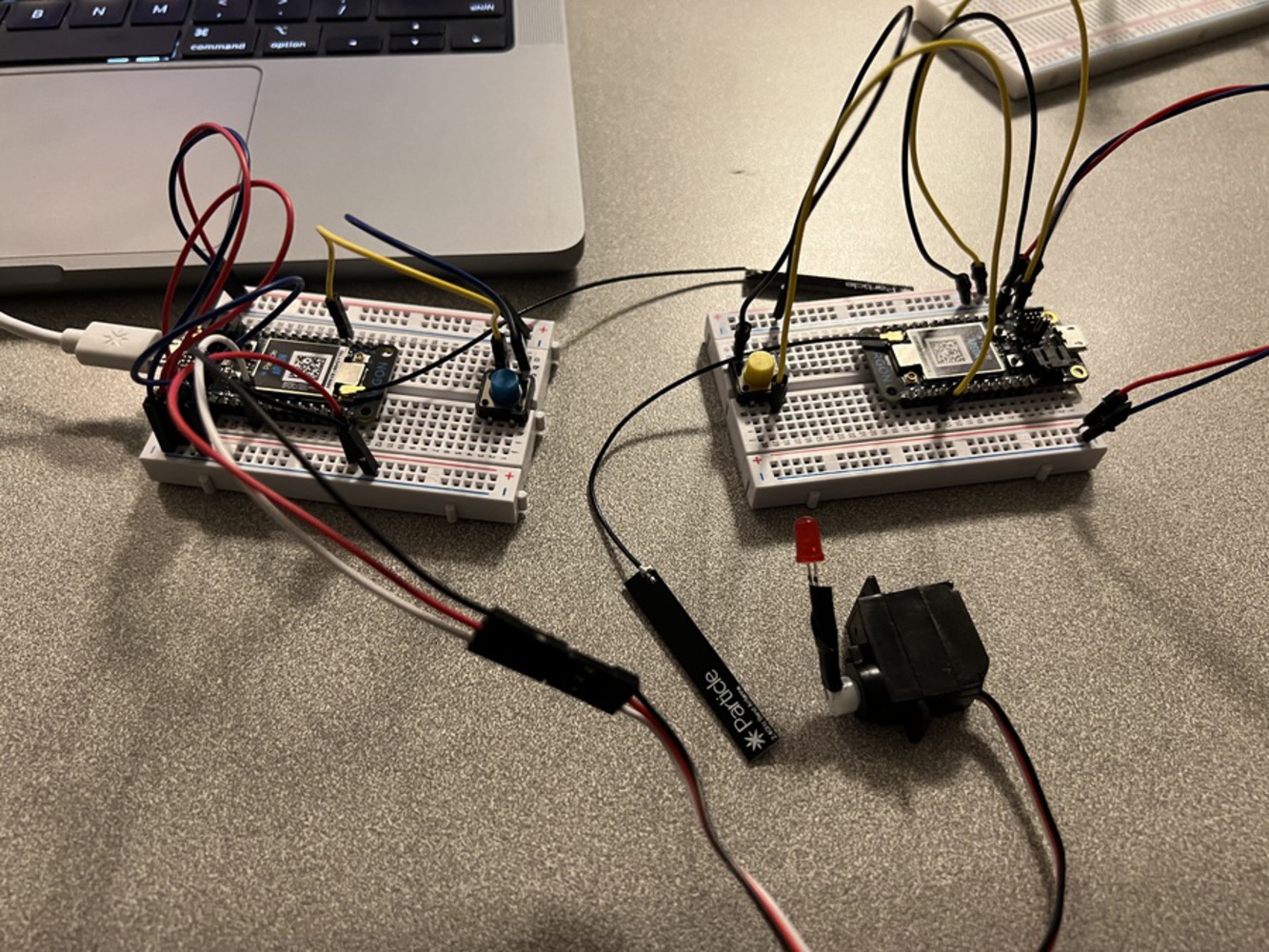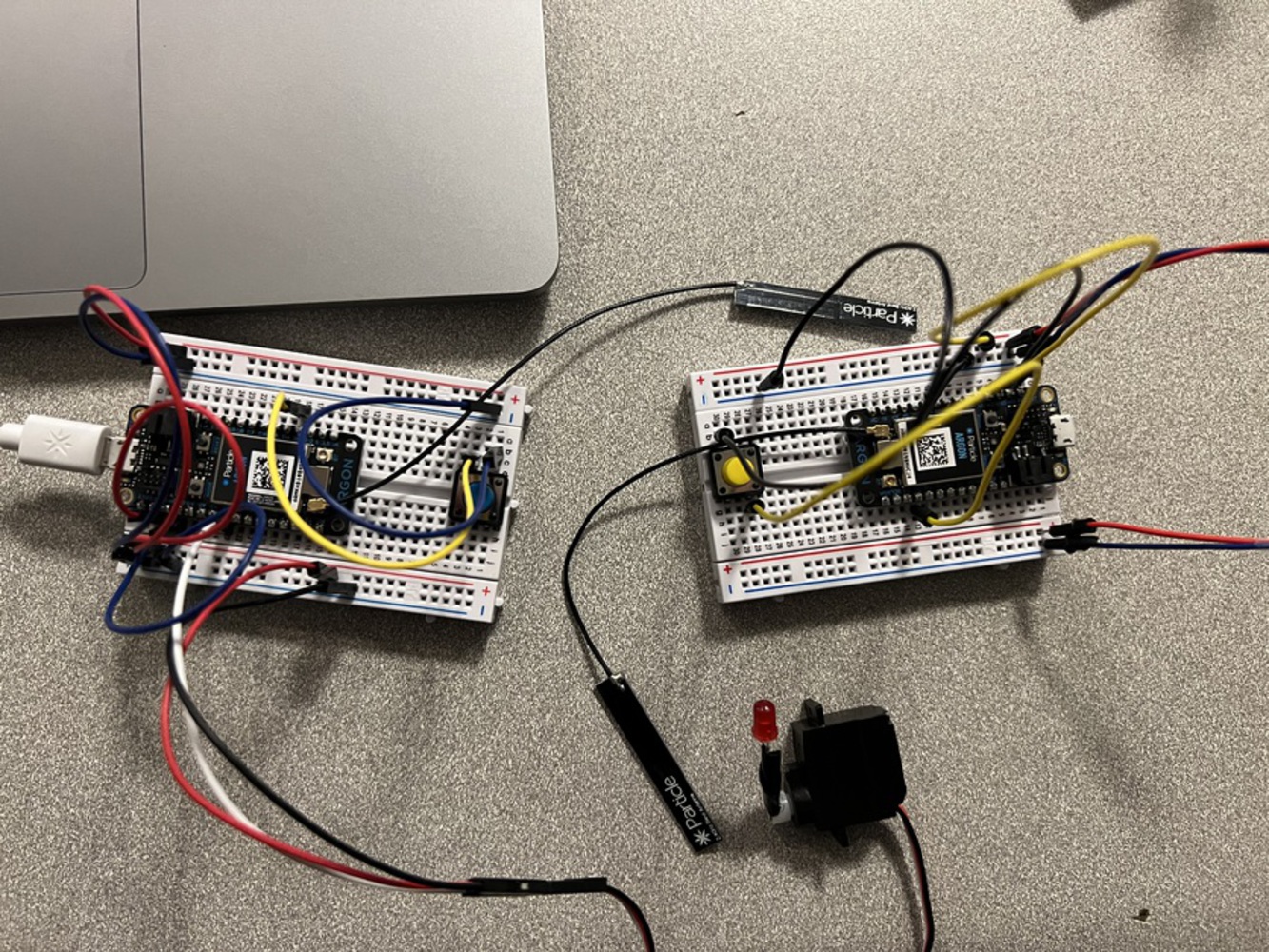Network 2 devices together.
Created: December 7th, 2021
0
int servoPin = A3;
Servo jamesServo;
int servoPos = 0;
int buttonPin = D3;
// This value will store the last time we published an event
long lastPublishedAt = 0;
// this is the time delay before we should publish a new event
// from this device
int publishAfter = 5000;
void setup() {
// attaches the servo on the A3 pin to the servo object
jamesServo.attach( A3 );
pinMode(buttonPin,INPUT_PULLUP);
// Keep a cloud variable for the current position
Particle.variable( "servoPos" , &servoPos , INT );
// We'll want to subscribe to an event thats fairly unique
// From the Particle Docs
// A subscription works like a prefix filter.
// If you subscribe to "foo", you will receive any event
// whose name begins with "foo", including "foo", "fool",
// "foobar", and "food/indian/sweet-curry-beans".
// Basically this will match any event that starts with 'db2018/paired/'
// This is a feature we'll useto figure out if our event comes from
// this device or another (see publishMyEvent below)
Particle.subscribe( "diot.2021.batman" , handleSharedEvent , "e00fce68555d32031781c22d" );
}
void loop()
{
// publish my event
// you'll want some more complex stuff here
if(digitalRead(buttonPin) == LOW){
publishMyEvent();
delay(1000);
}
}
void publishMyEvent()
{
// Remember that a device can publish at rate of about 1 event/sec,
// with bursts of up to 4 allowed in 1 second.
// Back to back burst of 4 messages will take 4 seconds to recover.
// So we want to limit the amount of publish events that happen.
// check that it's been 10 secondds since our last publish
if( lastPublishedAt + publishAfter < millis() )
{
// Remember our subscribe is matching "db2018/paired/"
// We'll append the device id to get more specific
// about where the event came from
// System.deviceID() provides an easy way to extract the device
// ID of your device. It returns a String object of the device ID,
// which is used to identify your device.
String eventName = "diot.2021.batman" + System.deviceID();
// now we have something like "diot/2019/paired/0123456789abcdef"
// and that corresponds to this devices info
// then we share it out
Particle.publish( eventName, String(random(0,180)), PUBLIC );
// And this will get shared out to all devices using this code
// we just pubished so capture this.
lastPublishedAt = millis();
}
}
// Our event handlde requires two bits of information
// This gives us:
// A character array that consists of the event name
// A character array that contains the data published in the event we're responding to.
void handleSharedEvent(const char *event, const char *data)
{
// Now we're getting ALL events published using "db2018/paired/"
// This includes events from this device.
// So we need to ignore any events that we sent.
// Let's check the event name
String eventName = String( event ); // convert to a string object
// This gives us access to a bunch of built in methods
// Like indexOf()
// Locates a character or String within another String.
// By default, searches from the beginning of the String,
// but can also start from a given index,
// allowing for the locating of all instances of the character or String.
// It Returns: The index of val within the String, or -1 if not found.
// We can use this to check if our event name contains the
// id of this device
String deviceID = System.deviceID();
// device id = 0123456789abcdef
// event = "diot/2019/paired/0123456789abcdef"
if( eventName.indexOf( deviceID ) != -1 ){
// if we get anything other than -1
// the event came from this device.
// so stop doing stuff
return;
}
String dataString = String( data );
servoPos = constrain( dataString.toInt(), 0 , 180 );
jamesServo.write( servoPos );
return;
// otherwise do your stuff to respond to
// the paired device here
//motorOn = true;
}Reflection
We were swamped with the final project and just made this work as quickly as we could. Initially, we didn't know we needed to implement the echo and got stuck where our devices were publishing events but they weren't detecting events from the other device. Once we included the echo, it worked without issue.

